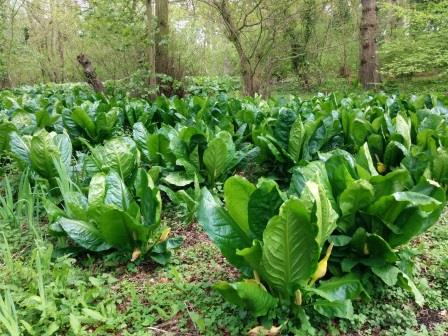Non-Native Invasive Species
Plants or animals which have been introduced into areas outside their natural range through human actions and are posing a threat to native wildlife, are described as invasive.
Potentially harmful, invasive, non-native species are as much a threat in the Isle of Man as in other parts of the world, with the increase in the transport of plants and animals by human activity and through climate change. See links to useful websites on the right.

Is this wetland plant likely to spread and become an invasive nuisance? It has escaped from more than one garden in the north of the Island. It is Lysichiton americanus. Its common name is American or Yellow Skunk Cabbage. This photograph, from a wetland in Norfolk (South Walsham Broad), shows how dominant it can become. Use the Plant Alert website to report potential invasive garden plants.
Chinese Mitten Crabs
Found in rivers, brackish water estuaries and rarely along marine inshore coast. Not yet seen around the island but has spread across the UK. See the Mitten Crab Recording project website.
Flatworms
Flatworms, sometimes known as Planaria, are small and slimy but also quite mysterious, with a hermaphrodite sex life. They particularly like the damp mild climate of the north western areas of the British Isles. There are two groups of flatworms, those with two eyes include the four probably native species (Microplana spp.) and those with multiple eyes, which are all introduced. The introduced species pose a potential threat to native earthworm populations. There are now at least ten of these alien species in the British Isles.
Here are descriptions of some of the flatworm species, three of which are potentially harmful invasive aliens. These are:
|
Invasive flatworm species: |
|
|
Arthurdendyus triangulatus New Zealand flatworm |
5-20cm long. Dark brown or purple/brown with pale spotted margin or underside. Shiny black egg capsules. It is an offence under the UK Wildlife and Countryside act to knowingly distribute this species in the UK because of the damage it can do. See pictures. |
|
Australoplana sanguinea Australian flatworm |
2-8cm long. Orange or pinkish with many minute eyes showing as black dots. Eats earthworms and is therefore a potential threat. See picture. |
|
Kontikia andersoni |
1-2.5cm long, pale brown with 3 rows of darker brown spots, unknown origin. Scavenges small, dead invertebrates. See picture. |
|
Kontikia ventrolineata |
Another recent introduction from Australia. It is 1-2cm long and eats small snails and slugs. There are no records yet from the Island but it has been recorded in Liverpool, Cornwall, Guernsey and recently in Scotland, suggesting that it is spreading. Not yet shown to be harmful. |
|
Flatworm species native in the British Isles: |
|
|
Microplana terrestris |
Two-eyed, 1-2 cm long, black, dark grey to brown, the most common UK species. A scavanger, feeds on dead slugs and earthworms. We have one record of this on the Isle of Man. |
|
Microplana scharffi |
Two-eyed, 2-5 cm long, bright yellow sometimes yellow grey or pinkish. Apparently a scavanger. No Isle of Man records to date. |



